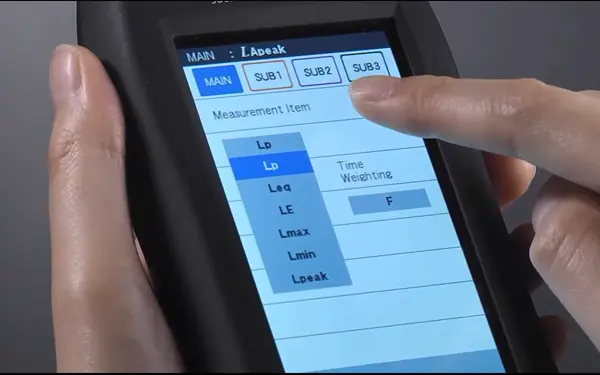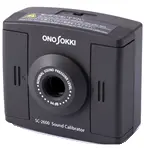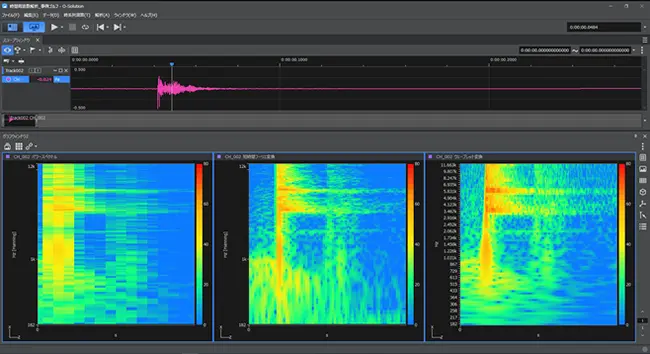High performance Sound Level Meter
LA-7000 series


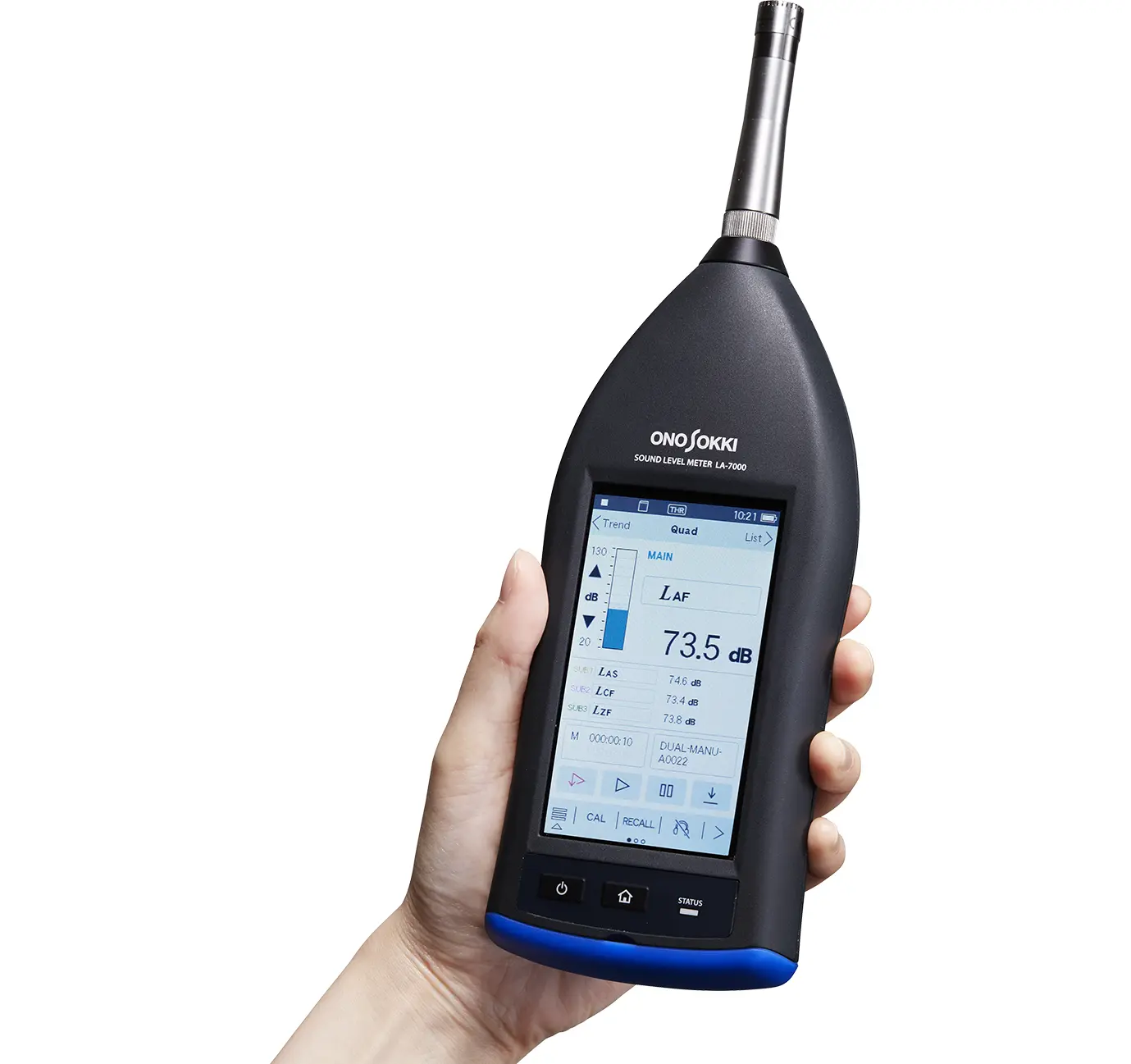

The LA-7000 series is newly designed sound level meter which operation procedure has been greatly improved. The large color LCD and touch panel enable easy and intuitive operation.
LA-7000 series allows “measuring while listening to sound” in addition to the original features of a sound level meter such as measurement and calculation.
By listening to the sound instantly at the measuring place, you can confirm condition of a target, perform sound source probing, and check that the sound is unfailingly being recorded. The LA-7000 series sound level meter is a great help for reliable measurement at measurement place where no mistakes can be allowed.
By adding various options, the LA-7000 series is able to be upgraded to a sound analyzer (frequency analysis) and a sound recorder*, performing more than just a sound level meter.
The measurement performance is substantially improved only using LA-7000 series which does multiple duties, such as sound measurement, sound recording, frequency analysis, and sound probing of abnormal sound.
By using LA-7000 series together with various analyses software, “waveform analysis”, “sound quality evaluation”, “fluctuation sound analysis”,and ”simulation of sound frequency” can also be performed.
High sensitivity type for measurement of small sound in an anechoic room
Measurement frequency range:
10 Hz to 20 kHz
Measurement level range (JIS, IEC) A:
20 to 128 dB
Self-noise level A: 12 dB or less
Wide band type for measurement of wide range from very low frequency sound to audible range
Measurement frequency range:
10 Hz to 20 kHz / 1Hz to 20 kHz
(When ultra low frequency sound measurement function available*1)
Measurement level range (JIS, IEC) A:
24 to 138 dB
Self-noise level A: 16 dB or less
High function type for measurement of environmental noise
Measurement frequency range:
10 Hz to 8 kHz
Measurement level range (JIS, IEC) A:
23 to 138 dB
Self-noise level A: 17 dB or less
Product video (YouTube)
Feature
Power can be supplied from USB.
Function
Standard function
Two (DUAL) and four (QUAD) calculated values can be displayed simultaneously by combining different frequency weighting and time weighting. It is effective for multiple weightings
| SINGLE mode | MAIN |
| DUAL mode | MAIN, SUB1 |
| QUAD mode | MAIN, SUB1, SUB2, SUB3 |
Example: QUAD mode screen
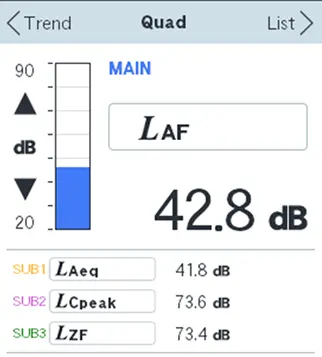
The displayed value is only the selected one.(MAIN or SUB)
*Trend display: combination of instantaneous values or calculated values
List > screen : Displays all calculation values(Lp, Leq, LE, Lmax, Lmin, Lpeak, LN)of now being measured of the selected MAIN or SUB.
*Tap MAIN or SUB to select, and the display changes to bold (selected).
It is possible to measure while listening to the sound.
● Effective for measurements in anechoic rooms and remote locations
● Effective for remote location monitoring due to environmental noise
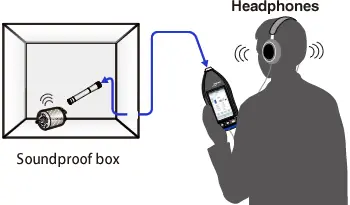
* Extension cable and headphones are sold separately.

RTA 1/1 mode
This is one of the frequency analysis modes which displays frequency divided by octave band. Vertical axis represents sound pressure level (sound loudness), and horizontal shows frequency (sound pitch). In this mode, it is obvious which pitch of sound is loud. Data comparison of RTA 1/1 data and MAIN data is available by overlapping drawing.

Filter 1/1 mode
By using the octave band filter, you can listen to only the interested sound even in noisy environment. It helps sound probing of abnormal sound. Data comparison of Allpass (all ranges) and Bandpass (specified band) is available.
| Conforming standard | IEC 61260-1:2014 Class1 / JIS C 1513-1: 2020 Class1 |
|---|---|
| Analysis band | 16 Hz to 16 kHz (11 bands), Allpass1, Allpass2 *When ultra low frequency sound measurement function available: 1 Hz to 16 kHz (15 bands) [List only],Allpass 1, Allpass 2 |
| Calculation item | Filter Mode (Bandpass, Allpass selectable)
・・・Lp, Leq, LE, Lmax, Lmin, Lpeak, LN list RTA Mode ・・・ Lp, Leq, LE, Lmax, Lmin (Main) |
| Measurement range | 10-80 dB, 20-90 dB, 30-100 dB, 40-110 dB, 50-120 dB, 60-130 dB, (excluding wide range) |
| Memory mode | Manual, Auto, Logging, Record* ( *when the LA-0704 installed ) |
- Overlay function RTA mode *
The octave function has an overlay function (OVERLAY), and it is possible to overwrite RTA memory data and measurement data (live data).
- Background noise correction function RTA mode *
This function is helpful to correct background noise.
Background noise values and measured values should be stable for the measurement.
Note on usage>
Cannot be measured if frequency band of background noise is wider than that of target noise (commonly occurs at low frequencies).
Using at LAeq (A characteristic time average noise level) is recommended.
*Background noise correction function can be used for RTA 1/3.


Sound calibration is important for reliable measurement. Storing the calibration history is useful for easy management of sound calibration.
Useful function 1:
Registration of the recommended calibrator to be used to the sound level meter
Registration item: Model of calibrator, calibration level value, serial number
Save items: (calibration value, VR position for adjustment,sound calibrator / internal reference signal, calibration date and time)
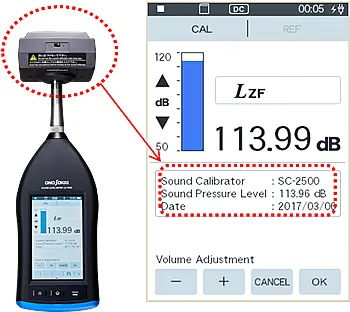
Useful function 2:
Automatically saving of calibration data in internal memory (When calibration mode is completed with OK, about 100 times max.)
Output of the calibration history data to the SD card (.csv format)
| Save items : | (calibration value, VR position for adjustment, sound calibrator / internal reference signal, calibration date and time) |

Optional function
It is possible to analyze and evaluate the sound which divided the octave band in more detail. It is also possible to listen to the sound through the 1/3 octave band filter. It is the analysis function and filter which are used most frequently in sound.

RTA 1/3 mode
This is one of the frequency analysis modes which displays frequency divided by octave band. Vertical axis represents sound pressure level (sound loudness), and horizontal shows frequency (sound pitch). In this mode, it is obvious which pitch of sound is loud. Data comparison of RTA 1/3 data and MAIN data is available by overlapping drawing.

Filter 1/3 mode
By using the octave band filter, you can listen to only the interested sound even in noisy environment. It helps sound probing of abnormal sound. Data comparison of Allpass (all ranges) and Bandpass (specified band) is available.
| Analysis band | 12.5 Hz to 20 kHz(33 bands), Allpass1, AIIpass2 * When Ultra low frequency sound measurement function available: 0.8 to 16 kHz (45 bands) [List only], Allpass, Allpass2 |
|---|---|
| bedient standard, calculation item, measuring range and memory mode | It's same as a mode 1/1 octaves. Please refer to it. |
This function can perform analysis with finer line resolution (narrow band analysis) up to 1600 lines. The narrow-band analysis of not only the loudness but also the sound pitch (frequency) can be performed. Effective for frequency analysis of single-shot sound using trigger function

● Simultaneous processing of auto-memory and FFT Analysis : Continuous saving of numerical data
● Simultaneous processing of record-memory and FFT Analysis (The LA-0704 required)
● Fine line resolution (800 lines, 1600 lines)
| Frequency range | 1 k, 2.5 k, 5 k, 12.5 k, 25 kHz |
|---|---|
| Number of lines (number of sampling points) | 400(1024), 800(2048), 1600(4096) |
| Trigger | ON/OFF times (1 to 16),Level (40.0 to 130dB),osition (64-point fixed) |
| Average mode | SUM, MAXhold, EXP (exponential) |
| Measurement range | Normal range (wide range: not supported) |
| Memory function supported | Manual, Auto, Logging, Record |
| Screen expand display (Expand) | ×1, ×2, ×4 |
Easy recording by selecting memory mode "Record" and by pushing (Start) button.

| Memory mode | Record |
|---|---|
| Sampling frequency | 64 kHz |
| Recording time | approx. 8 hours (4 GB, at 16-bit recording) approx. 5.5 hours (4 GB, at 24-bit recording) |
| Recording range | Normal range (Not support at 16-bit wide range) |
| File format | wav (audio data)and csv (trend data for playback : Lz at 1s intervals) |
(note) Up to 2 GB of recording by OS-2000 (recorded data with LA).
Recording should be within the following time.
Recording time:
4.5 hours (2 GB, at 16-bit recording)
3 hours (2 GB, at 24-bit recording)
In addition to playback and preview on the main unit, recalculation such as Leq, reanalysis such as FFT, RTA, and RTA can be performed. When you want to perform further analysis, you can transfer data to the secondary processing software.

・RTA1/1, Filter 1/1 mode
・RTA1/3, Filter 1/3 mode: LA-0702 required
・FFT mode : LA-0703 required
Note) Trigger function is not available.
Note) Time setting is only MeasureTime.
*L-SIM mode LA-0707 and SQE mode (LA-0708A) L-SIM mode (LA-0707) and SQE mode (LA-0708A): Available ver. 4.0 or higher.
Level judgment by the sound is available to perform the pass/ fail judgment of the products.
Output cable (Multi I/O-BNC connector) 2 m : provided as standard
*OFF setting: gray

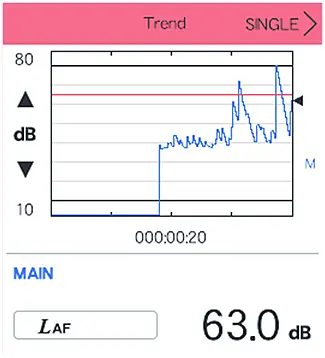
| Judging item | SLM mode (SINGLE/DUAL/QUAD) Lp instantaneous value in Main Filter 1/1, 1/3 (BP:Lp), RTA1/1, 1/3 (AP1:Lp), FFT (OA:Inst) (Calculated value: not supported) |
|---|---|
| Setting level | 30.0 dB to 130.0 dB |
| DELAY setting | OFF, 10 ms, 100 ms, 1 s, 2 s, 3 s, 5 s, 10 s |
| HOLD setting | 00 ms, 200 ms, 500 ms, 1s, 5 s, 10 s, 30 s, Manual |
| Output mode | OFF, ON (Mode1LOW), ON (Mode2HI-z) |
By simulating the specific noise measures, you can check the sound before and after the countermeasure and find more effective methods for controlling noise.
You can confirm the effect in advance by hearing the virtual sound after the countermeasure. Checking the frequency component (RTA function; standard),
listening the sound through filter (Filter function: standard) are also effective.
You can also obtain the overall value.



| Measurement mode | L SIM |
|---|---|
| Switching display (Phone mark) | UD (Simulation possible) or AP (original sound) |
| Adjustment range | - 50 dB to + 20 dB (1dB step) |
| Variable level correspondence | 16 Hz to 16 kHz (11 bands) |
| Display band | 11 bands, Overall, Allpass (Through) |
| Batch edit function | 0 dB (for reset), - 50 dB (all cut) |
| Display at UD setting | MAIN : Overall value (increased or decreased calculation value) List display : edit amount for each band, and numerical value after increase / decrease |
|---|---|
| UD setting output | Phone terminal |
| Headphone output | virtual sound (sound with UD setting) |
| AC output | Overall output (UD setting output) |
| AC/DC terminal | Selectable from ·DC output: Overall output (UD setting output) ·AC-Z output: Z output (Z-weighting live sound) ·Through output: microphone output (output of leveled live sound) |
If the evaluation indicated by the noise level is different from the human hearing sense, sound quality evaluation such as loudness value is a very effective means.
*LA-0708A: intended for stationary sound measurement. For Loudness of not -stationary sound, use the sound quality evaluation software of OS-2000 series.
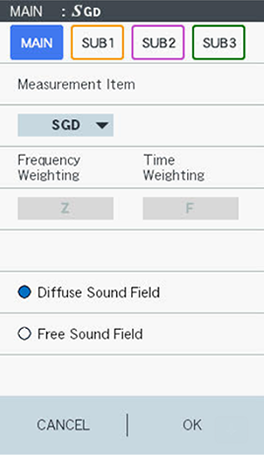

| Usage | stationary sound, Diffuse sound field(GD), free sound field (GF) selectable | |||||||||||||
|---|---|---|---|---|---|---|---|---|---|---|---|---|---|---|
| Operation list |
|
|||||||||||||
| Simultaneous measurement | Main | 1 from calculation list above | ||||||||||||
| SUB1 | LAeq | |||||||||||||
| SUB2/SUB3 | (1 for each from SLM values) | |||||||||||||
| Measurement range | normal range | |||||||||||||
* CI (Comfort Index) is one of the evaluation values of sound by the teacher Ms. Kuwano Sonoko's* research.
CI is a value obtained by adding "sharpness value" and "1/10 of A-weighting time average sound level".
There are correlation examples of environmental noise and mechanical noise,
and this index is considered to be effective as an evaluation amount of harsh sound. Currently the range of application is studied. Please use it as a reference value.
Ms. Sonoko Kuwano * (Engineering Ph.D.) : Emeritus Professor of Osaka University Chairman of the Acoustical Society of Japan, Vice Chairman of the Japan Sound Control Engineering Association, Vice Chairman of the International Acoustical Society
Ultra low frequency sound (1 to 20 Hz) that is hard to hear with human ears can be measured.
| Measurement frquency range | 1 Hz to 20 kHz (10 Hz to 20 kHz or 1 Hz to 20 kHz selectable by mode selection) |
|---|---|
| Frequency weighting | G weighting selectable |
| Time weighting | 10 s selectable |
| Conforming standard | ISO7196:1995 Acoustics - Frequency-weighting characteristic for infrasound measurements |
| Mode | SLM (SINGLE, DUAL, QUAD), FILTER (1/1 Filter, 1/3 Filter), RTA (1/1 RTA, 1/3 RTA), FFT/td> |
*Can only be installed on LA-7500. For adding LA-0709 to LA-7500 after purchase, Installation will be done by Ono Sokki. Please contact us for details.
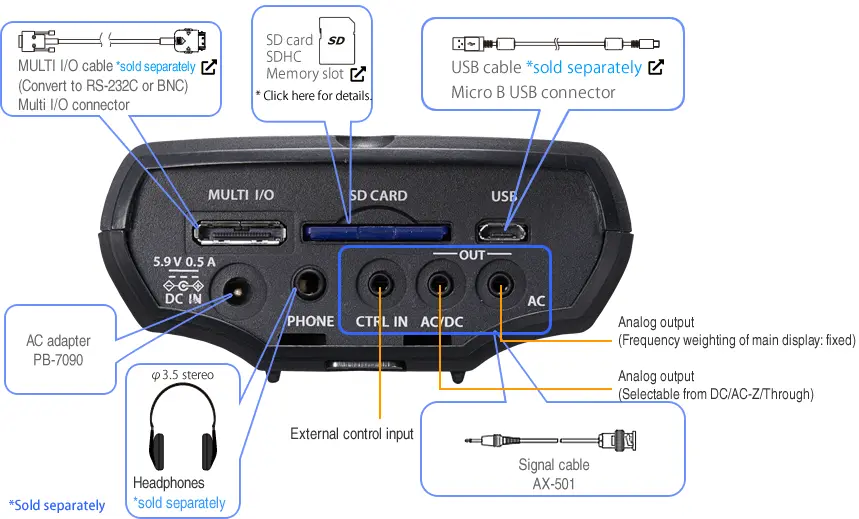
Accessory
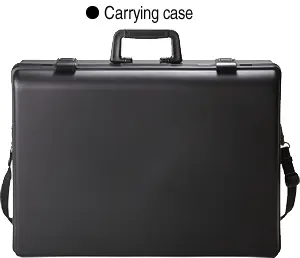

Specification
| LA-7700 Class1 | LA-7500 Class1 | LA-7200 Class2 | ||||||||||||
|---|---|---|---|---|---|---|---|---|---|---|---|---|---|---|
| Applicable standard |
JIS C 1509-1: 2017 Class1 JIS C 1516 : 2020 Class1 |
JIS C 1509-1: 2017 Class2 JIS C 1516 : 2020 Class2 |
||||||||||||
| IEC 61672-1: 2013 Class 1 | IEC 61672-1: 2013 Class 2 | |||||||||||||
| ANSI S1.4-2014/Part1 Class1 | ANSI S1.4-2014/Part1 Class2 | |||||||||||||
| Measurement frequency range | 10 Hz to 20 kHz | 10 Hz to 20 kHz 1 Hz to 20 kHz*1 |
10 Hz to 8 kHz | |||||||||||
| Measurement level range (IEC, JIS) | A: 20 to 128 dB C: 28 to 128 dB Z: 34 to 128 dB |
A: 24 to 138 dB C: 32 to 138 dB Z: 38 to 138 dB Z: 50 to 138 dB *1 G: 35 to 138 dB *1 or more*1 |
A: 23 to 138 dB C: 30 to 138 dB Z: 36 to 138 dB |
|||||||||||
| Self-noise level | A: 12 dB or less C: 20 dB or less Z: 26 dB or less |
A: 16 dB or less C: 24 dB or less Z: 30 dB or less G: 27 dB or less*1 |
A: 17 dB or less C: 24 dB or less Z: 30 dB or less |
|||||||||||
| Microphone | MI-1281 | MI-1271 | MI-1471 | |||||||||||
| Microphone preamplifier | MI-3270 | |||||||||||||
| Linearity range | Wide range: 110 dB / Normal range: 80 dB | |||||||||||||
| Level range | 10 to 120 dB (wide)/50 to 120 dB/40 to 110 dB/30 to 100 dB/20 to 90 dB/10 to 80 dB/0 to 70 dB | 20 to 130 dB (wide)/60 to 130 dB/50 to 120 dB/ 40 to 110 dB/30 to 100 dB/20 to 90 dB/10 to 80 dB |
||||||||||||
| Reference range | 50 to 120 dB | |||||||||||||
| Time weighting e.g.: LAF | F (fast), S (slow), I (impulse) and 10 ms | F (fast), S (slow), I (impulse), 10 ms and 10 s*1 | F (fast), S (slow), I (impulse) and 10 ms | |||||||||||
| Frequency weighting e.g.: LAF | A, C and Z | A, C, Z and G*1 | A, C and Z | |||||||||||
| Measurement items | Lp, Leq, LE, Lmax, Lmin Lpeak, L N (L5, L10, L50, L90, L95, Lhigh, Llow, Lave, and two more of any LN data) |
|||||||||||||
| Sampling interval | 15.6 µs (Lp, Leq, L E, Lmax, Lmin, Lpeak), 100 ms (LN) | |||||||||||||
| Measurement time | e.g.: If you want to measure a fixed 10-minute period every hour, and wish to measure this for 24 hours, M.T:10 minutes, P.T: 1 hour, and T.T: 24 hours |
|||||||||||||
| Measurement time (Meas.Time) |
Manual (OFF), user-specified setup: 0.1 to 199 hour 59 min. 59.9 sec. resolution: 0.1 sec. | |||||||||||||
| Period time (Period Time) |
1 min. to 24 hours / resolution: 1 min. | |||||||||||||
| Total Time (Total Time) |
0.1 sec. to 999 hour 59 min. 59.9 sec. / resolution: 0.1 sec. | |||||||||||||
| Start mode | Manual start, timer start, count down start, level start | |||||||||||||
| Display device | 4.3-inch LCD with color backlight (touch panel type) | |||||||||||||
| Digital display | 4-digit/ resolution: 0.1 dB/ update cycle: 1 s | |||||||||||||
| Bar indicator | Wide range: 100 dB of display range/ Normal range: 70 dB of display range | |||||||||||||
| Remaining battery level display | 4-step display | |||||||||||||
| Operation mode | (Online) mode |
|
| |||||||||||
|
Offline mode (LA-0704 required) |
|
|||||||||||||
| Overlay display | Overlay display | Standard: RTA 1/1 Option: RTA 1/3 (LA-0702) |
||||||||||||
| Background noise correction | Standard: RTA 1/1 Option: RTA 1/3 (LA-0702) |
|||||||||||||
| Memory function | Stored in an SD/SDHC card (SDHC card: up to 32 GB.) | |||||||||||||
| Memory mode |
|
|||||||||||||
| Panel condition memory | Internal memory (internal condition : 5, EZ condition : 5, power off memory : 1), SD or SDHC card memory (number : depends on the capacity) |
|||||||||||||
| Basic measurement mode | 5 modes (EZ1: LAeq+LCpeak, EZ2: Record, EZ3: Logging 100 ms, EZ4: NC, EZ5: Loudness) | |||||||||||||
| Clock function |
Built-in (year/ month/ day/ hour/ minute) Continuous operation time : approx. 1 year (charging time: 24 hours from entire discharge state) |
|||||||||||||
| Calibration history function |
Built-in memory (number of stored points: approx. 100 points), Content (Calibration value, VR position for control, internal reference signal of used sound calibrator, calibration date) |
|||||||||||||
| Resume function | Stores measurement conditions into the built-in memory | |||||||||||||
| Calibration | Reference signal (when connecting external device) |
Electronic calibration by built-in transmitter (1 kHz sine wave) Normal range: -6 dB of full-scale Wide range: -16 dB of full-scale |
||||||||||||
| Recommended calibrator | SC-2600,SC-2500A | SC-2600,SC-2500A | SC-2600,SC-2500A, SC-2120A | |||||||||||
| Output/Input | Phone output (headphone output) |
Actual sound or recorded sound (playback sound) Selected 1 band of actual sound or recorded sound (playback sound) in 1/1 octave filter (standard function) or 1/3 octave filter mode (option: LA-0702) When "UD" of level simulator (LSIM: LA - 0707) is selected, level editing sound. When "AP" is selected, the real sound. Maximum output : 0.03 mW (63 Ω: at 1kHz) Connector : stereo φ3.5 |
||||||||||||
| AC output | Outputs one of A, C, or Z interlocked with the main display | |||||||||||||
| AC output level |
|
|||||||||||||
| AC/DC output | Selectable form DC, AC-Z or Through | |||||||||||||
| DC output level | 2.5 V ±20 mV (normal range, wide range) when range full-scale input,1MΩ loaded
|
|||||||||||||
| AC-Z output level |
|
|||||||||||||
| Through output level |
0.707 Vrms ±5 % (normal range/ wide range) when full-scale input, 1MΩ loaded Distortion rate (range full scale): 0.2% or less |
|||||||||||||
| External control input |
|
|||||||||||||
| Level judgment output(*LA-0705) | Open collector (output withstand voltage : DC+24V or less, sink current : 20mA or less) *Output cable (Multi I/O -BNC connector 2 m) : provided as standard |
|||||||||||||
| Level judgment comparison item | SLM mode (Main : Lp), Filter 1/1,1/3 (Main (BP) : Lp), RTA1/1,1/3 (AP1 : Lp), FFT (OVERALL : Instant) | |||||||||||||
| Interface | RS-232C | Baud rate: 9600, 115200 bps, multi I/O cable (sold separately) | ||||||||||||
| USB
|
Compliant with USB high speed storage class specification ver. 2.0,
|
|||||||||||||
| External memory | SD/SDHC memory card (SDHC : up to 32 GB)*3 | |||||||||||||
| Applicable extension cable (for microphone extension) *4 |
103 m (CE conforming cable: up to 30 m)…AG-3400 series *Cable extension exceeding 5m : with correction function. |
|||||||||||||
| Power supply | · Size AA battery (alkaline battery cell or Ni-MH secondary vattery) x 4 pieces · USB bus power (operating input voltage range: 4.75 to 5.25 VDC) · AC adapter (PB-7090, power consumption: approx. 7 VA when using 100 VAC) |
|||||||||||||
| External power operation function |
The main unit is activated automatically when the power is supplied from an AC adapter. (This function is not available by battery cells.) Switch on/off can be done with the switch in the battery box (standard function) |
|||||||||||||
| Windscreen correction function |
Function to correct the influence of windscreen (φ70)/
All-weather type windscreen (LA-0207A) LA-7700 : all-weather type windscreen cannot be used with |
|||||||||||||
| Battery life (continuous use) *5 |
Alkaline battery cell LR6 : approx. 12 hours Ni-MH secondary battery: approx. 12 hours |
|||||||||||||
| Operating (storage) temperature range | -10 to 50 °C (-20 to 60 °C) | |||||||||||||
| Operating (storage) humidity range | 20 % to 90 %RH (10 % to 90 %RH ) with no condensation | |||||||||||||
| Outer dimensions | Approx. 90(W)×279(H)×42(D) | |||||||||||||
| Weight | Approx. 540 g (including batteries) | |||||||||||||
| Accessories | ·AC adapter (PB-7090)*6 ·Hand strap ·SDHC memory card (16G) |
·Signal cable (AX-501) ·Size AA battery cell x 4 pieces ·Iinstruction manual (CD) |
·Windscreen (φ70 mm) ·Carrying case (including shoulder belt) ·Setup guide |
|||||||||||
*1: Available with the LA-0709 Ultra low frequency sound measurement function
*2: Supported ver.2.0 or higher version of firmware
*3: Please use a recommended SD card when you use the SD memory function.
*4: The described value is extendable length when the exclusive cable is used.
*5: It depends on the using status such as operation mode, memory mode, and backllight.
*6: Please contact your nearest distributor or Ono Sokki sales office nearby for the outlet cable used for overseas.
Option
| Model | Name |
|---|---|
| LA-0702 | 1/3 Octave Analysis function (RTA mode/Filter mode) |
| LA-0703 | FFT Analysis function (Narrow band frequency analysis) |
| LA-0704 | Sound recording function / Offline analysis function |
| LA-0705 | Level judgment function |
| LA-0707 | Level simulator function |
| LA-0708A | Sound quality evaluation function |
| LA-0709 | Ultra low frequency sound measurement function |
Related products
LA-7200 (Class 2): SC-2600, 2500A, 2120A
LA-7500 (Class 1): SC-2600, 2500A
Using the all-weather type windscreen reduces noise caused by the wind when performing sound level measurement outdoors, and prevents the microphone from being damaged by rain or snow.
Screen diameter : Φ 200 mm
Mounting screw : 1/4-20 UNS depth 6 (screw for tripod attachment)
*Set the extension cable correction function in the main unit of the LA-7000 series before use.
* Conforms to IEC 61672-1:2013 and JIS C 1509-1:2017 when the LA-0207A is attached to the sound level meter.
* Periodical exchange is necessary for the expendables
(windscreen, waterproof mesh).
* Cannot be used for LA-7700 (Class 1).

| Microphone can be used away from the main unit of sound level meter by connecting exclusive extension cable. *Set the extension cable correction function in the main unit of the LA-7000 series before use. |
| AG-3401 (5 m), AG-3402 (10 m), AG-3403 (20 m), AG-3404 (30 m) |
(Product Code: PE19B2458)*
U2C-AMBF2U12BK (ELECOM)
Micro-USB (A–microB) cable, 2A output compatible, 1.2 m, with ferrite core
USB (A) → USB (microB) (sound level meter side)
*Internal product code
| USB(A) | USB(microB) (Sound level meter side) |

|
|
| D-sub 9pin (Serial port side) |
MULTI/IO (Sound level meter side) |

|
|
(Product Code: PE3534088*)
Interface for RS-232C (2 m)
*Code of Ono Sokki
O-Solution/DS-5000
Detailed analysis with Analysis mode
By importing the data (wav format) recorded by the LA-7000 series (+LA-0704, option) into the O-Solution, you can play back sounds, perform frequency analysis, and octave analysis on your PC. In addition, by using the IIR filter (option), it is possible to listen to the sound after passing through the filter while playing back the recorded sound.
Signal input source for the DS-5000
Real-time analysis can be performed by inputting the analog output of the LA-7000 series to the DS-5000 instead of a microphone. Since the LA-7000 series can simultaneously output a signal with A-weighting and a flat (Z-weighting) signal, it is possible to analyze them simultaneously with the DS-5000.


When a human listens to a sound, various sensations such as loudness, sharpness, and roughness occur.
This function enables to obtain sound quality evaluation indicators that take into consideration the human hearing characteristics and correspond to various sensations of sound.
The fluctuation sound analysis is the analysis that can extract only the components with large time fluctuation that are not affected by the level. As a result, it becomes possible to quantify the characteristics of various temporal fluctuations that were difficult to detect with conventional FFT, basic roughness or fluctuation strength. In addition, since it can be evaluated with two axes of sound tone (high and low) and time fluctuation cycle for various sound designs (applying effect), deeper analysis than conventional technology is possible.
This function can evaluate transient phenomena that were difficult to capture by FFT analysis, and display clearly time change of the frequency component while maintaining its frequency resolution . The OS-0527 is equipped with STFT (Short Time Fourier Transform) and Wavelet transform.
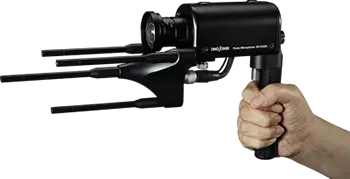
This system can visualize the sound. Effective when you want to perform further analysis after specifying the location of bothering sound by using the LA-7000 octave bandpass filter.
Related information
Revised: 2024/07/05


